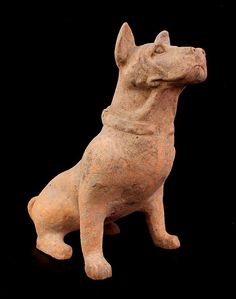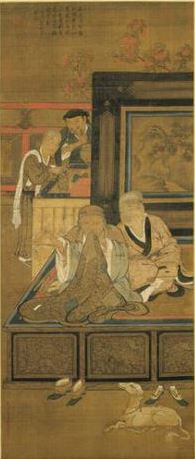
The Dog (狗) is the eleventh of the 12-year cycle of animals in the Chinese zodiac. The Year of the Dog is associated with the Earthly Branch (地支) symbol Xū (戌). 16 February 2018 is the Lunar New Year Day of Year Wù Xū (戊戌年).
天干 (the Ten Heavenly Stems) :
甲乙丙丁戊己庚辛壬癸
地支 (the Twelve Earthly Branches) :
子丑寅卯辰巳午未申酉戌亥
十二生肖:鼠牛虎免龍蛇馬羊猴雞狗豬 (12-year cycle in the Chinese zodiac)
Rat ox tiger rabbit dragon snake horse goat monkey rooster dog pig
Recent years of the Dog in the Chinese Lunar Calendar are 1922, 1934, 1946, 1958, 1970, 1982, 1994, 2006, 2018.
Chinese Zodiac years are based on the Chinese lunar calendar, starting at Chinese New Year (16 February in 2018). People born in January or February can check the date of the Chinese New Year to confirm their birth sign, for example at the following
https://www.chinahighlights.com/travelguide/chinese-zodiac/dog.htm
Characteristics of Dogs
Dogs are loyal, honest, reliable, courageous and hardworking. They are amiable, kind and prudent. Dogs also show great leadership.
Dogs in Ancient Chinese History
It is believed that the dog is the first species to be domesticated. Bone remains of dogs have been discovered in human burial sites of the Neolithic Period (around 8500 BC to 2500 BC). Early humans started to make hunting tools and they used the dog’ robust sense of smell to help them hunt. In return humans gave dogs protection and food consistently. The cohabitation of dogs and humans would have greatly improved the chances of survival.
Domesticated dogs were mainly divided into four types, watchdogs, hunting dogs, dog for diet and toy dogs favoured as pets by the aristocracy and rich people. Dogs have been human’s best friends for a very long time. To the western people eating dog is cruel and totally unacceptable. For ancient people and people in poor places today, raising dogs for diet is easier than raising bigger animals like pigs and cows. However later in Chinese history, dog was taken away from the dinner table possibly because of the fear of catching rabies diseases.
A lot of burial sites in China have been unearthed during the past 60 years. Some dated back to Neolithic Period (around 8500 BC to 2000 BC). They were quite primitive. Bones of dogs have always been found in burial sites. Nanyang (南陽) a historical city in central China’ Henan Province (河南省) is famous for its wealth of relics dating back to the Han Dynasty (206 BC to 220 AD). Of the large number of figurines unearthed in burial sites, pottery dogs are among the most popular. People at that time believed that there was an afterlife after the death of the physical body. Rich people and the aristocracy have elaborated and solemn funeral ceremonies. According to literature, savoury cooked dog dishes were offered to the deceased.
People at that time believed that dogs were able to protect them from evil and help them enjoy a peaceful afterlife. The dog was also one of the 12 signs of the Chinese zodiac. This is another reason for its popularity as a tomb figurine. Pottery dogs were always found buried alongside their owners.
Different postures of pottery dogs have been unearthed together with other pottery items of everyday utensils. Some pottery dogs are standing up at alert, with their heads raised, pricked up ears as hunting dogs. Some have their mouths half-opened and two protruding eyes as if they are barking and guarding the property as watchdogs. The watchdogs were often placed near the tomb entrance. Some are squatting and some are reclining as if taking a break.
The pottery dogs figurines vary in size and shape with the largest standing 60 cm and the smallest 5 cm tall. The pottery dog figurines were mostly made of grey clay and occasionally red clay. With the development of glazing in the middle and late Han Dynasty, the earthenware figurines were covered with a low-fired, lead-fluxed coating, with copper added as a colouring before it was fired in a kiln. Copper green and iron-derived yellow and reddish brown make up the palette of the Han glazed pottery dogs.





(Photo credits: Pinterest, saved from Live Auctioneers)

A recumbent dog with its head tilted upwards, the mouth agape exposing the tongue and fangs.
(Photo credits: Pinterest, saved from Christies.com.)




Dogs in Chinese Paintings











More dog paintings of Giuseppe Castiglione





Acknowledgements:
I would like to thank Professor P. Lam for his kind guidance and advice for writing the webpages.
Bibliography :
https://en.wikipedia.org/wiki/Chinese_zodiac
https://www.chinahighlights.com/travelguide/chinese-zodiac/dog.htm
Bjaaland Welch, Patricia (2008) Chinese Art- A guide to Motifs and Visual Imagery Tuttle Publishing ISBN: 978-08048-3864-1
户辅圣 (2003) 中国画历代名家技法图典 花鸟编 (中) 上海书画出版社
中国剪纸 Paper Cut in China 十二生肖 The twelve symbol animals 漢坤東方出品




